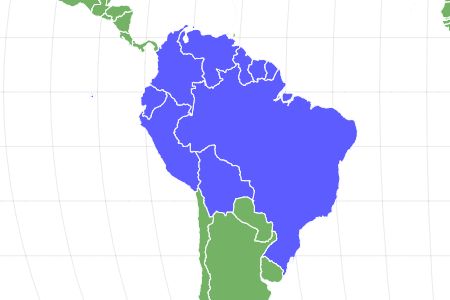Unau (Linnaeus’s Two-Toed Sloth)
Choloepodidae didactylus
Its top speed is 0.17mph
Advertisement
Unau (Linnaeus’s Two-Toed Sloth) Scientific Classification
- Kingdom
- Animalia
- Phylum
- Chordata
- Class
- Mammalia
- Order
- Pilosa
- Family
- Choloepodidae
- Genus
- Choloepus
- Scientific Name
- Choloepodidae didactylus
Read our Complete Guide to Classification of Animals.
Unau (Linnaeus’s Two-Toed Sloth) Conservation Status
Unau (Linnaeus’s Two-Toed Sloth) Facts
- Prey
- Insects, small vertebrates
- Name Of Young
- Baby sloths, pups
- Group Behavior
- Solitary
- Fun Fact
- Its top speed is 0.17mph
- Estimated Population Size
- Unknown
- Biggest Threat
- Predation, habitat loss, car collisions
- Most Distinctive Feature
- Two toes on front legs
- Other Name(s)
- Linnaeus's two-toed sloth, Linne's two-toed sloth, Megalonychidae
- Gestation Period
- 6 months
- Litter Size
- 1
- Habitat
- Rainforests and cloud forests
- Predators
- harpy eagles, jaguars, ocelots, anaconda snakes, domestic dogs, and humans
- Diet
- Omnivore
- Favorite Food
- Vegetation, insects, small vertebrates
- Type
- Xenarthran
- Common Name
- unau, two-toed sloth, southern two toed-sloth
- Number Of Species
- 1
- Location
- Central and South America
Unau (Linnaeus’s Two-Toed Sloth) Physical Characteristics
- Color
- Brown
- Grey
- Green
- Skin Type
- Hair
- Top Speed
- 0.17 mph
- Lifespan
- 20-40 years
- Weight
- 8.8-17.6lbs
- Length
- 23-28 inches
- Age of Sexual Maturity
- 3 years for females, 4-5 years for males
- Age of Weaning
- 1 year
View all of the Unau (Linnaeus’s Two-Toed Sloth) images!
The Unau also called Linnaeus’s two-toed sloth is thought to be the slowest mammal in the world.
The sloth species is found in South America. It is nocturnal and lives in the trees of tropical and subtropical rainforests, where the climate is hot and humid and there are a lot of vines. Having a greyish-brown color and a greenish tint, it is about two feet long.
5 Incredible Unau Facts!
- Linnaeus’s two-toed sloth is larger than the three-toed sloth and with some other physical differences.
- It is a good swimmer but does not move well on the ground, where it is vulnerable to predation.
- Sloths move so slowly because they have an extremely slow metabolism.
- It eats less than half of the calories of similar-sized mammals.
- There is another two-toed sloth called Hoffman’s sloth, which lives in Central and South America.
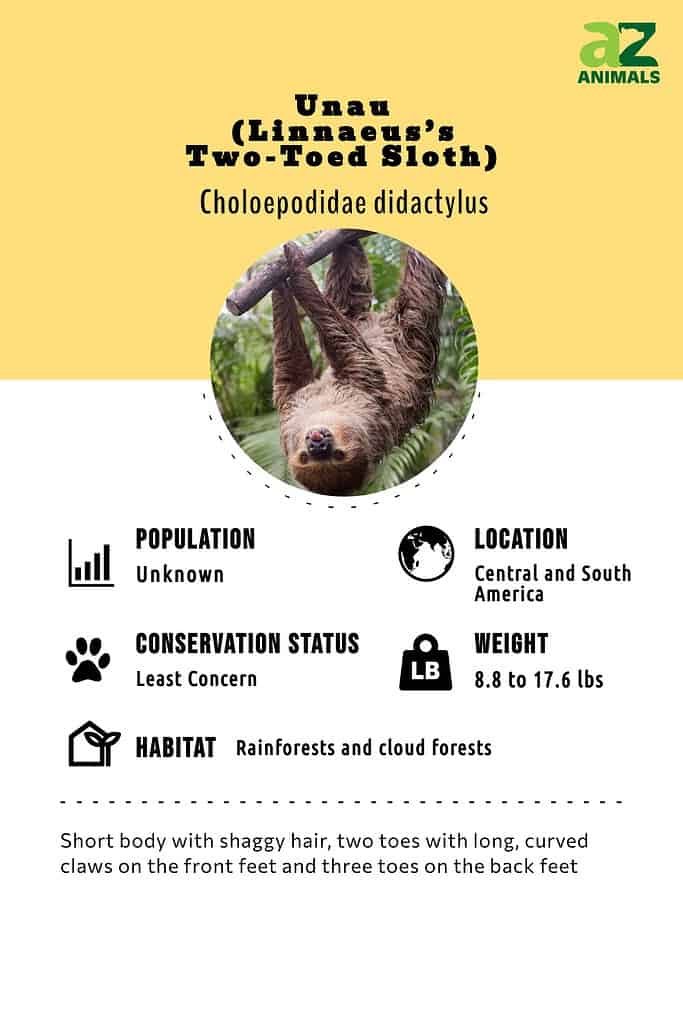
Scientific Name
The common name of the Unau is a southern two-toed sloth or two-toed sloth, while an alternate name is Linnaeus’s two-toed sloth, to distinguish it from Hoffman’s two-toed sloth. The pronunciation of Unau is written as yü-ˈnȯ, ˈyü-ˌnȯ, or ü-ˈnau̇. It comes from the Tupí word unaü or uná meaning lazy. Its class is Mammalia (mammals) and its family is Choloepodidae or Megalonychidae (two-toed sloths), which contains Linnaeus’s two-toed sloth along with Hoffman’s two-toed sloth. Both belong to the genus Choloepus, which means “lame foot.” They are two of six types of sloth, with a classification of either two-toed or three-toed.
Evolution And Origin

The two-toed sloth was related to the South American Mylodon, an extinct ground sloth.
©iStock.com/Christopher R Mazza
Sloths are members of the superorder, xenarthra which puts them in the same family as armadillos and anteaters. These animals originated in South America during the late Paleocene around 60 million years ago. There are two different types of sloths, two-toed and three-toed, and while they may seem similar, they come from different ancestors. The two-toed sloth is related to the giant South American Mylodon, a ground sloth that went extinct less than 10,000 years ago, and the three-toed sloth has two relatives – the ground sloth, Megalonyx, which was a horse-sized creature from North American that lived until about 15,000 years ago, and Megatherium, an elephant-sized animal.
Types Of
There are a total of six different species of sloths, of which belong to two different types – the two-toed sloths, which have two species, and the three-toed sloths, which have four species.
- Linnaeus’s two-toed sloth (Choloepus didactylus)
- Hoffman’s two-toed sloth (Choloepus hoffmanni)
- Brown-throated sloth (Bradypus variegatus)
- Pale-throated sloth (Bradypus tridactylus)
- Maned sloth (Bradypus torquatus) – vulnerable
- Pygmy three-toed sloth (Bradypus pygmaeus) – Critically endangered and at risk of becoming extinct.
Appearance
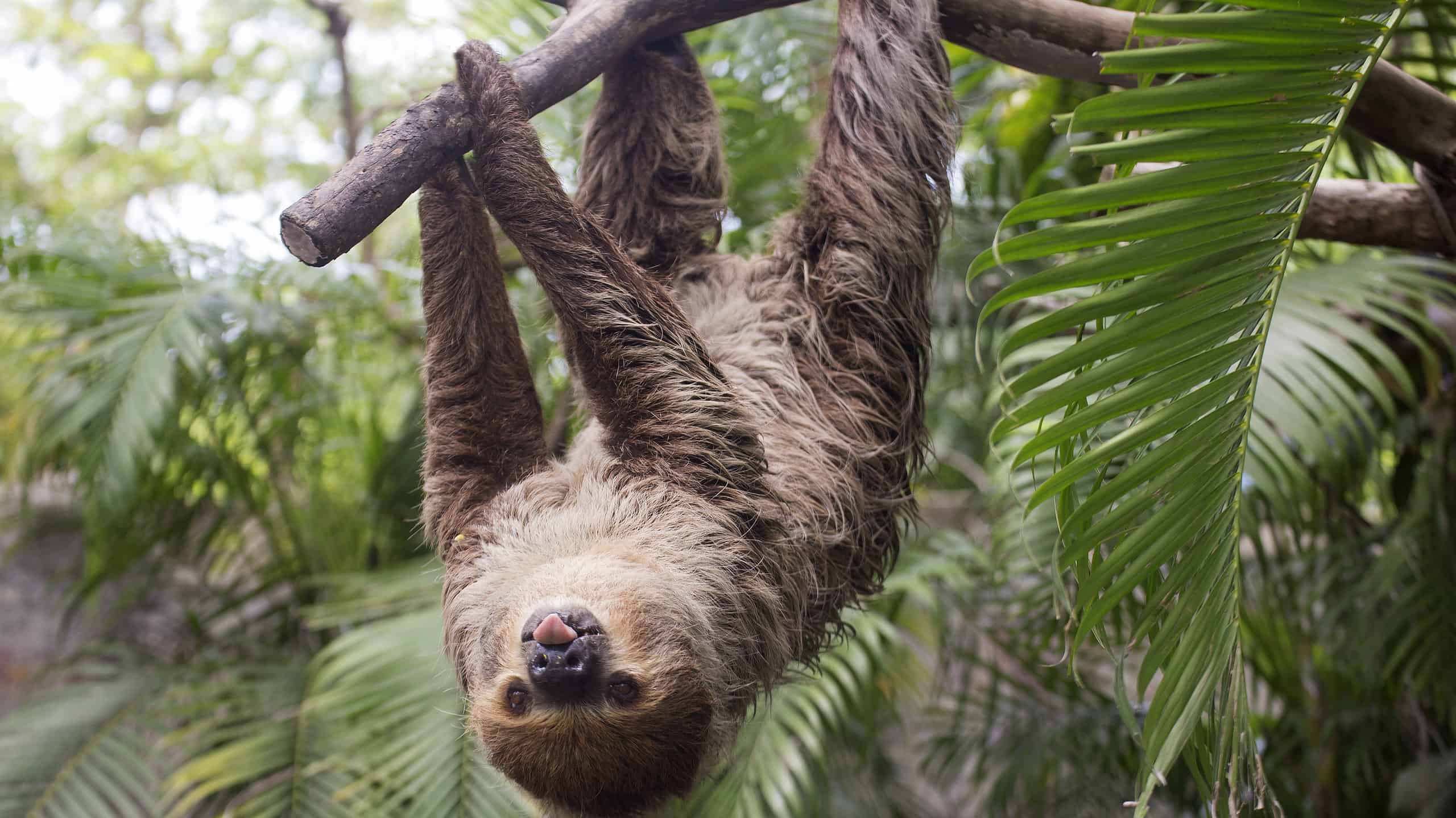
You can identify the two-toed sloth by its front legs which has two toes with claws.
©iStock.com/Kung_Mangkorn
Unlike other sloths, the identification of the two-toed sloth shows two toes on its front legs. However, its back legs have three toes as all sloths do. It has alternating light and dark brown, coarse fur to serve as camouflage among the trees, where it is invisible while not moving. The bristly outer layer of fur is six inches long and covers an undercoat of finer, shorter hairs. It is 23-28 inches long with an average of two feet and weighs 8.8-17.6lbs. Also, it’s the slowest mammal in the world.
Identification of it compared to the three-toed sloth also shows bigger eyes, longer fur, and more equal length of the front and back legs. Other differences for identification are a larger head, ears, and hind feet, long arms, and a shorter tail. Sometimes, its fur has a reddish tint but it usually has a greenish tint from algae. The shape of its mouth gives it a permanent smiling expression, made more obvious by its short snout. The few teeth of four to five sets it has do not include incisors or true canines. A group of sloths is called a bed, or more commonly, a snuggle.
Behavior
Like other sloths, it is solitary and quiet. However, it is aggressive and can move very fast if it needs to. When threatened, it makes low cries, moans, and hisses. Sloths are generally the world’s slowest animals and this species is the world’s slowest animal because of their incredibly slow metabolism. It does well climbing in the rainforest or even swimming, but not moving on the ground. The nocturnal, solitary, arboreal (tree-dwelling) animal spends most of its time hanging upside-down from trees. Since it cannot walk, it pulls itself hand-over-hand. Unlike the three-toed sloth, it descends head-first. Although the unau can be active during the day, it spends 90 percent of its time motionless and sleeps 15-20 hours a day. It moves 6.5 feet per minute on the ground and 10 feet per minute in trees.
Habitat
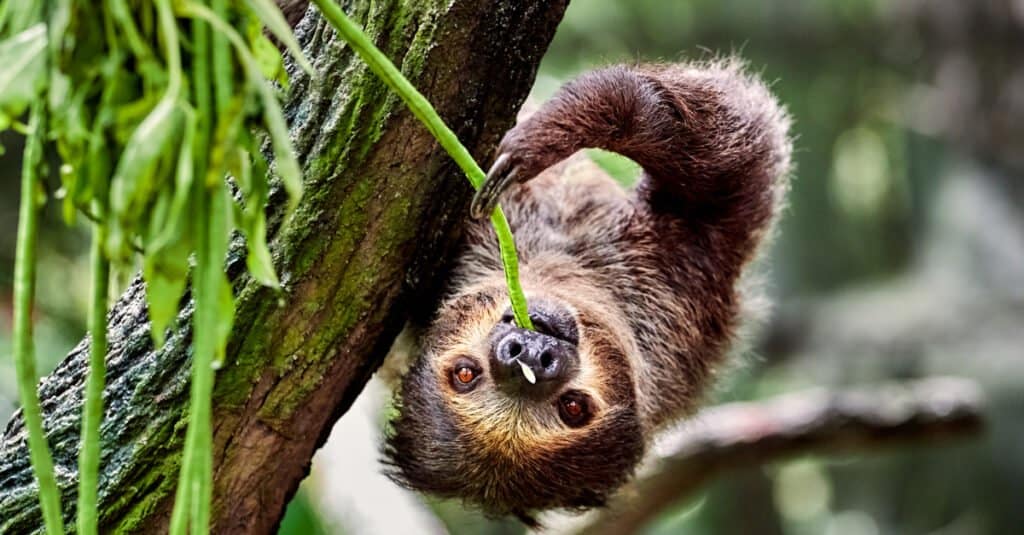
and lives in the hot and humid climates of rainforests and cloud forests.
©J_K/Shutterstock.com
Because the unau is so sedentary, algae grow on its fur, which helps camouflage its fur. A small, thin body and large eyes help it be less noticeable while allowing it to see better, and its thick, long fur helps keep it warm. Moving in and out of the shade to keep warm, it keeps a body temperature of 86°F-93°F. It only leaves trees once a week to defecate on the ground. The long claws help it cling to tree branches.
Because it has little muscle and a very slow metabolism, it cannot shiver and relies on the temperature to keep warm – namely, the hot and humid climates of tropical and subtropical rainforests and cloud forests that make up its habitat. Its habitat range expands into Bolivia and includes Brazil north of the Amazon River, Peru, Ecuador, Colombia, Venezuela, and the Guyanas. Its range spans from northern South America east of the Andes Mountains and south to the central Amazon basin. Living in the high canopies of rainforests, each sloth has a home range of about 10 acres. When it wakes up at night to eat, it moves to a new tree for food but rarely passes more than 131 feet or 41 yards.
Diet
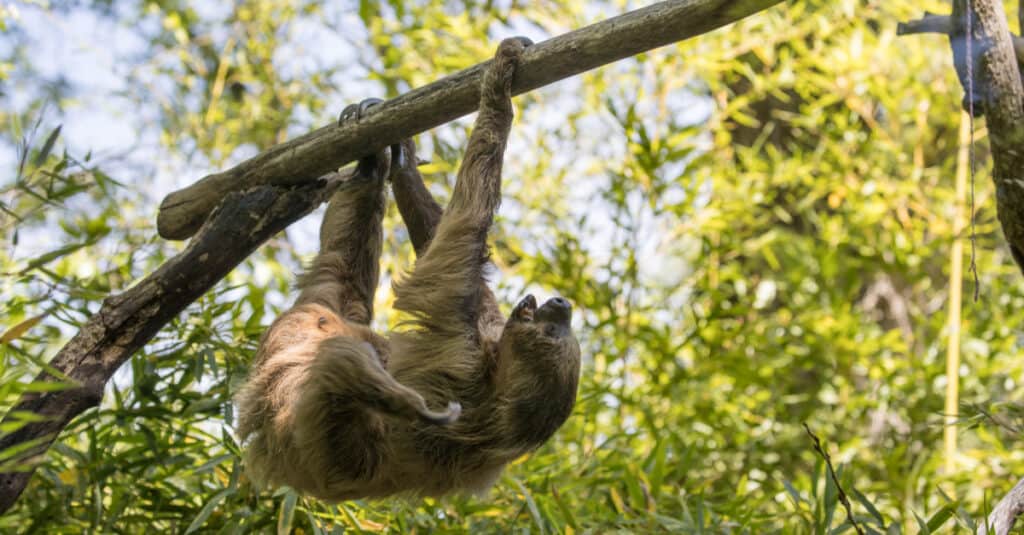
Unau, Linnaeus’s two-toed sloth (Choloepus didactylus) is an omnivoure.
©Saad315/Shutterstock.com
The Unau’s diet is omnivorous. It is a combination of herbivorous (plant-eating) and insectivorous, with the Unau eating leaves, fruit, twigs, buds, flowers, shoots, bark, berries, nuts, insects, bird eggs, rats, mice, and sometimes it resorts to eating the algae off of its fur for nutrition. It uses its lips to eat, smacking them together in place of incisors, which it does not have.
Having a low metabolism means it survives on very little food. Whereas other animals can digest food in a matter of hours, it takes days for the unau, even up to a month. Like many herbivores, it has a large, four-chambered stomach for fermenting and digesting plant matter. It gets water mostly from the vegetation it eats but sometimes drinks directly from rivers. Unique teeth with no enamel are not similar to those of other mammals.
Predators And Threats
The Unau is a strong swimmer. On the ground, however, it is vulnerable to predation. Predators of the unau are harpy eagles, jaguars, ocelots, anaconda snakes, domestic dogs, and humans. Humans hunt them for their coats, meat, and claws. They also shoot them for rainforest logging. Unau is often hit by cars on roads near their rainforest habitats. Although this species is not endangered, deforestation decreases the trees the Unau can rely on for shelter and food.
Reproduction And Life Cycle
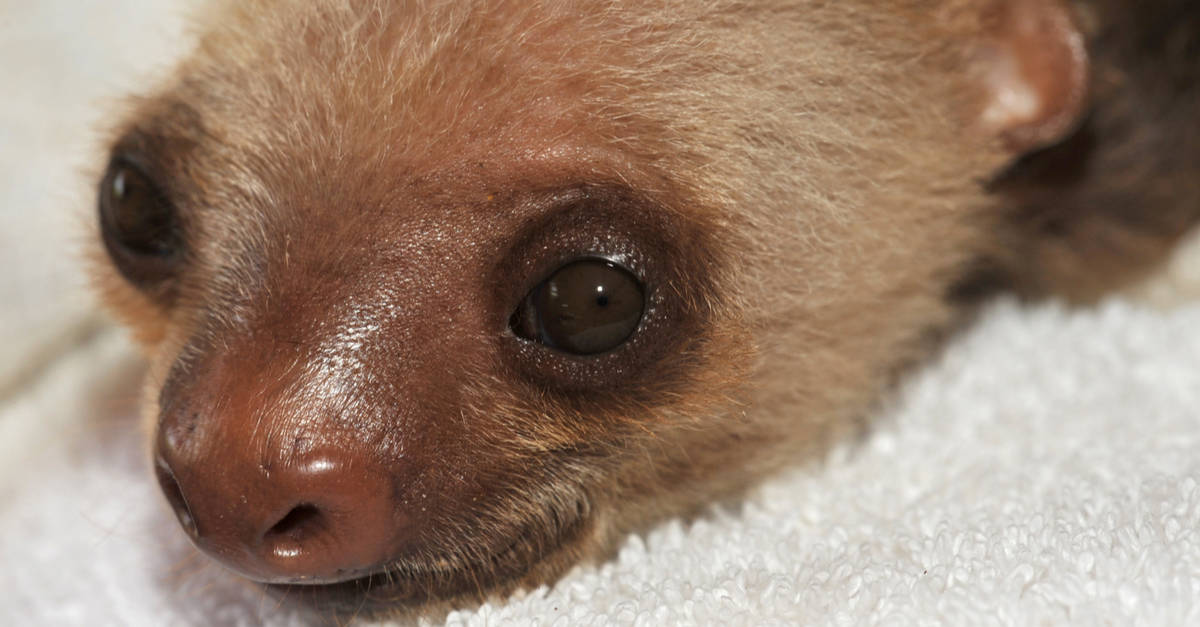
Baby unau, or two toed sloth, cling to their mother’s belly for the first five weeks of its life.
©worldswildlifewonders/Shutterstock.com
Not many facts are known about Unau mating patterns. What is known so far is that they are promiscuous and females initiate mating, which they engage in year-round. Their peak season may be March and April. Males are called boars and females are called sows. Females give birth once a year to live young. With a gestation period of six months, they give birth to a single baby. There is no unique word for baby sloths; they are simply called baby sloths or pups. The baby clings to its mother’s belly for the first five weeks of its life. It becomes independent at 1 year of age, although it stays with its mother until it reaches 2 years old. Females reach sexual maturity at 3 years and males at 4-5 years.
The lifespan of the Unau is 20-40 years, with a lifespan of 20 years in the wild and 30-40 years in captivity. The longest lifespan is of the Guinness World Record’s oldest sloth in captivity, a female named Paula from Germany, age 50.
Population
Not many facts are known about Unau’s population numbers. Its classification is listed as Least Concern on the IUCN Red List, with a population classification of unknown. This species is not endangered, but others of the six sloth species are endangered due to habitat loss and hunting.
View all 16 animals that start with UUnau (Linnaeus’s Two-Toed Sloth) FAQs (Frequently Asked Questions)
Where do unau sloths live?
Northern South America.
How much does a baby two-toed sloth cost?
$6,000-10,000 for a baby bred in captivity.
Is it possible to have a pet sloth?
It depends on the state you live in, where laws determine whether it’s legal to have a pet sloth.
Is an unau the slowest animal in the world?
Yes! Its top speed is 0.17 mph.
Are unau sloths carnivores, herbivores, or omnivores?
They’re really omnivores, although their diet is mainly herbivorous.
What is the pronunciation of unau?
The pronunciation of unau is yü-ˈnȯ.
Thank you for reading! Have some feedback for us? Contact the AZ Animals editorial team.
Sources
- Wikipedia, Available here: https://en.wikipedia.org/wiki/Linnaeus's_two-toed_sloth
- Britannica, Available here: https://www.britannica.com/animal/sloth/Two-toed-sloths#ref180774
- Merriam-Webster, Available here: https://www.merriam-webster.com/dictionary/unau
- Zoo New England, Available here: https://www.zoonewengland.org/stone-zoo/our-animals/mammals/linne-s-two-toed-sloth/
- Loveland Living Planet Aquarium, Available here: https://thelivingplanet.com/animal/linnaeus-two-toed-sloth/
- A Little Bright, Available here: https://alittlebright.com/sloths/
- The Sloth Conservation Foundation, Available here: https://slothconservation.org/what-do-you-call-a-group-of-sloths/
- Active Wild, Available here: https://www.activewild.com/sloth-information-and-facts-for-kids/
- Wikipedia, Available here: https://en.wikipedia.org/wiki/Two-toed_sloth
- WWF, Available here: https://www.worldwildlife.org/stories/why-are-sloths-slow-and-six-other-sloth-facts
- Animalia, Available here: https://animalia.bio/linnaeuss-two-toed-sloth
- The Knowledge Burrow, Available here: https://theknowledgeburrow.com/what-fruit-do-two-toed-sloths-eat/
- Runyon Canyon, Available here: https://runyoncanyon-losangeles.com/blog/how-do-two-toed-sloths-reproduce/
- Cincinnati Zoo, Available here: http://cincinnatizoo.org/wp-content/uploads/2013/05/Two-Toed-Sloth-complete.pdf
- Neeness, Available here: https://neeness.com/what-are-the-rainforest-snakes-that-eat-sloths/
- Kids Guinness World Records, Available here: https://kids.guinnessworldrecords.com/news/2019/10/the-worlds-oldest-sloth-595431

